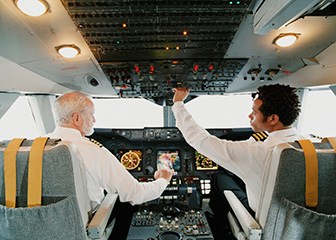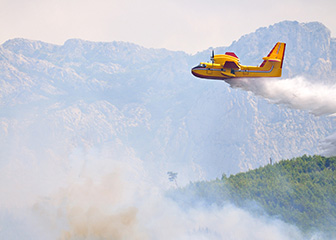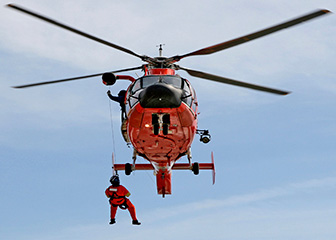How to Become an Airline or Commercial Pilot About this section

Students often use flight simulators to learn how to fly.
Many pilots learn to fly in the military, but a growing number now earn an associate’s or bachelor’s degree from a civilian flying school. All pilots who are paid to transport passengers or cargo must have a commercial pilot's license and an instrument rating. To qualify for a commercial pilot’s license, applicants must be at least 18 years old and have at least 250 hours of flight experience.
Education and Training
Military veterans have always been an important source of experienced pilots because of the extensive training and flight time that the military provides. However, an increasing number of people are becoming pilots by attending flight school or taking lessons from a Federal Aviation Administration (FAA) certified instructor. The FAA certifies hundreds of civilian flight schools, including some colleges and universities that offer pilot training as part of an aviation degree.
In addition, most airline companies require at least 2 years of college and prefer to hire college graduates. In fact, most pilots today have a bachelor’s degree. Because the number of college-educated applicants continues to increase, many employers are making a college degree an entry-level requirement. Preferred courses for airline pilots include English, math, physics, and aeronautical engineering.
Because pilots must be able to make quick decisions and react appropriately under pressure, airline companies will often reject applicants who do not pass psychological and aptitude tests.
Once hired by an airline, new pilots undergo additional company training that usually includes 6-8 weeks of ground school and 25 hours of additional flight time. After they finish this training, airline pilots must keep their certification by attending training once or twice a year.
Licenses
Commercial pilot’s license. All pilots who are paid to transport passengers or cargo must have a commercial pilot's license. To qualify for this license, applicants must be at least 18 years old and have at least 250 hours of flight experience.
Applicants must also pass a strict physical exam to make sure that they are in good health, must have vision that is correctable to 20/20, and must have no physical handicaps that could impair their performance.
In addition, they must pass a written test that includes questions about safety procedures, navigation techniques, and FAA regulations.
Finally, they must demonstrate their flying ability to an FAA-designated examiner.
Instrument rating. To fly during periods of low visibility, pilots must be rated to fly by instruments. They may qualify for this rating by having at least 40 hours of instrument flight experience. Pilots also must pass a written exam and show an examiner their ability to fly by instruments.
Airline certifications. Currently, airline captains must have an airline transport pilot certificate. In 2013, new regulations will require first officers to have this certificate as well. Applicants must be at least 23 years old, have a minimum of 1,500 hours of flight time, and pass written and flight exams. Furthermore, airline pilots usually maintain one or more advanced ratings, depending on the requirements of their particular aircraft.
All licenses are valid as long as a pilot can pass periodic physical, eye, and flight examinations.
Advancement
Many civilian pilots start as flight instructors, building up their flight hours while they earn money teaching. As they become more experienced, these instructors can move into jobs as commercial pilots.
Commercial pilots may begin their careers flying charter planes, helicopters, or crop dusters. These positions typically require less experience than airline jobs require. Some commercial pilots may advance to flying corporate planes.
In nonairline jobs, a first officer may advance to captain and, in large companies, to chief pilot or director of aviation. However, many pilots use their commercial experience as a steppingstone to becoming an airline pilot.
Airline pilots may begin as flight engineers or first officers for regional airline companies. Newly hired pilots at regional airline companies typically have about 2,000 hours of flight experience.
Over time, experience gained at these jobs may lead to higher paying jobs with major airline companies. Newly hired pilots at major airline companies typically have about 4,000 hours of flight experience.
For airline pilots, advancement depends on a system of seniority outlined in union contracts. Typically, after 1 to 5 years, flight engineers may advance to first officer and, after 5 to 15 years, to captain.
Important Qualities
Communication skills. Pilots must speak clearly when conveying information to air traffic controllers. They must also listen carefully for instructions.
Depth perception. Pilots must be able to see clearly and judge the distance between objects.
Detail oriented. Pilots must watch many systems at the same time. Even small changes can have significant effects, so they must constantly pay close attention to many details.
Monitoring skills. Pilots must regularly watch over gauges and dials to make sure that all systems are in working order.
Problem-solving skills. Pilots must be able to identify complex problems and figure out appropriate solutions. When a plane encounters turbulence, for example, pilots assess the weather conditions, select a calmer airspace, and request a route change from air traffic control.
Quick reaction time. Because warning signals can appear with no notice, pilots must be able to respond quickly to any impending danger.
Teamwork. Pilots work closely with air traffic controllers and flight dispatchers. As a result, they need to be able to coordinate actions on the basis of the feedback they receive.





